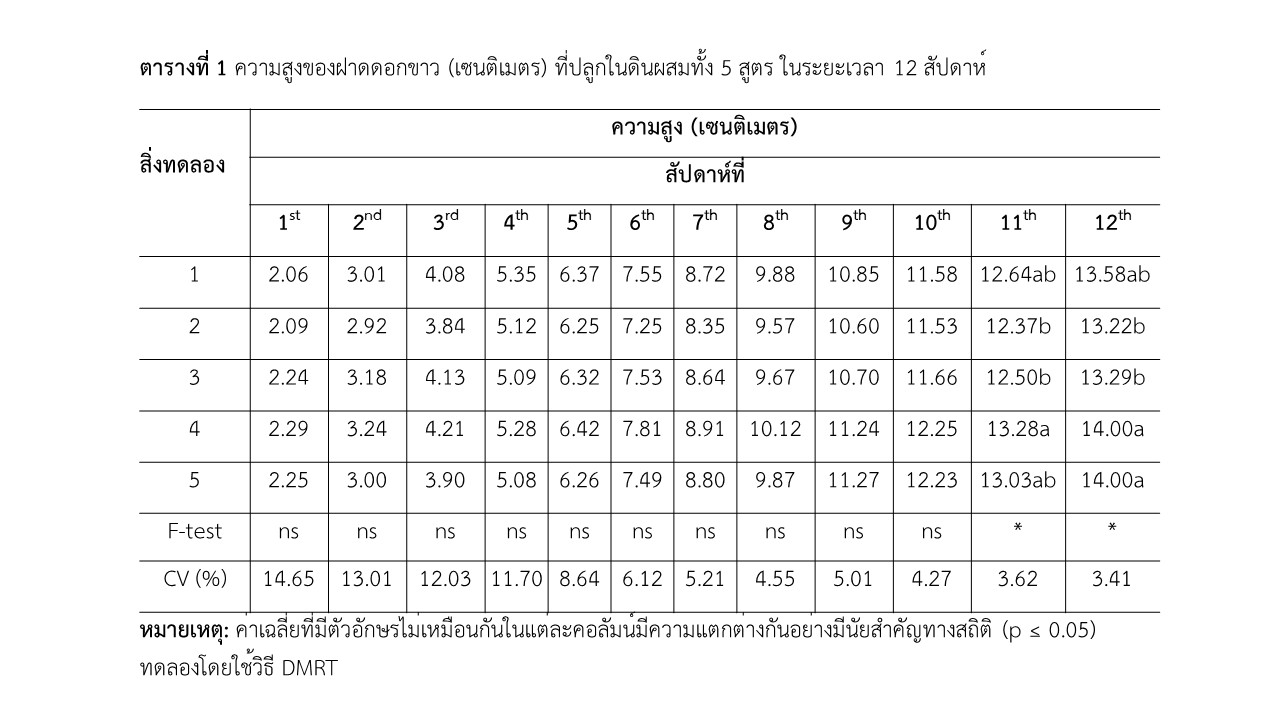The Study of Soil Mixed to the Growth of Mangrove Shrub Plants for Development as Ornamental Plants
Main Article Content
Abstract
This experiment was carried in the greenhouse of the Landscape Technology Program, Faculty of Agriculture, Rajamangala University of Technology Srivijaya, Nakhon Si Thammarat Campus, Thung Song District, Nakhon Si Thammarat Province, from April 20 to July 20, 2019. The purpose of the study was to examine suitable soil mixture formulas for the growth of three mangrove shrub species—Sonneratia caseolaris (white-flowered mangrove), Sonneratia alba (red-flowered mangrove), and Pluchea indica (Indian camphorweed)—for use as ornamental plants in landscape design. Each plant species was grown separately in 12-inch pots, using five different soil mixtures: Formula 1 (1:1:1:1 ratio of loam soil, composted manure, rice husk ash, and coconut husk), Formula 2 (2:1:1:1), Formula 3 (1:2:1:1), Formula 4 (1:1:2:1), and Formula 5 (1:1:1:2). The experiment followed a Completely Randomized Design (CRD), with each soil formula tested in 10 replications. Data were analyzed using ANOVA in SPSS, and treatment means were compared using Duncan’s New Multiple Range Test (DMRT) at 95% and 99% confidence levels (P ≤ 0.05 and P ≤ 0.01). Results showed that Sonneratia caseolaris grew best in soil mixtures 4 and 5, reaching 14.00 cm in height and producing 12.00 and 10.80 new leaves, respectively, by week 12. Sonneratia alba also performed well in the same two mixtures, growing to 15.03 and 15.00 cm with 12.11 and 11.25 new leaves. Meanwhile, Pluchea indica responded best to mixtures 1 and 5, reaching heights of 12.80 and 11.80 cm and producing the same number of new leaves—12.80 and 11.80—by the twelfth week.
Article Details

This work is licensed under a Creative Commons Attribution-NonCommercial-NoDerivatives 4.0 International License.
References
ส่วนส่งเสริมและพัฒนาทรัพยากรป่าชายเลน สำนักอนุรักษ์ทรัพยากรป่าชายเลน กรมทรัพยากรทางทะเลและชายฝั่ง, คู่มือความรู้เรื่องป่าชายเลนกรุงเทพฯ: โรงพิมพ์บริษัทพลอยมีเดียจำกัด, 2556.
วัฒนา ณ นคร และสุรศักดิ์ ชูทอง, รายงานการวิจัยการศึกษาอัตราส่วนดินผสมที่เหมาะสมการปลูกไม้พุ่มชายเลนเพื่อพัฒนาเป็นไม้ประดับในงานภูมิทัศน์, คณะเกษตรศาสตร์ มหาวิทยาลัยเทคโนโลยีราชมงคลศรีวิชัย, 2562.
เอื้อมพร วีสมหมาย, หลักการจัดสวนในบ้าน, กรุงเทพฯ: บริษัท โอเอสพริ้นติ้งเฮาส จำกัด, 2530.
มุกดา สุขสวัสดิ์, วัสดุปลูกไม้ดอกไม้ประดับ, กรุงเทพฯ: บ้านและสวน, 2547.
Khasa, D.P., Fung, M. and Logan, N.B. “Early growth response of container frown selected woody boreal seedling in amended composite talling and sand,” Bioresource Technology, vol. 96, no.7, pp 857-864, May 2005.
ประยงค์ ธรรมสุภา, “การศึกษาวัสดุปลูกที่เหมาะสมต่อการเจริญเติบโตของดาวเรือง”วารสารวิจัยและนวัตกรรมท้องถิ่น, ปีที่ 7, ฉบับที่ 1, หน้า 26–31, มกราคม - มิถุนายน 2555.
วิทยา สุริยาภณานนท์, อาหารและเครื่องปลูกของพืชสวน, กรุงเทพฯ: เอกสารคำสอนภาควิชาพืชสวน มหาวิทยาลัยเกษตรศาสตร์, 2528.
สุมิตรา สุปินราช และอิศร์ สุปินราช “ผลของวัสดุปลูกต่อการเจริญเติบโตของผักกาดหอมกระถาง”. วารสารวิทยาศาสตร์เกษตร, ปีที่ 49, ฉบับที่ 1, หน้า 47-52, มกราคม-เมษายน 2561.
วิจิตร วังใน, ธาตุอาหารกับการผลิตพืชผล, กรุงเทพฯ: มหาวิทยาลัยเกษตรศาสตร์, 2552.
Department of Land Development, Handbook of Land Development for volunteered soil doctor and farmers, Bangkok: Ministry of Agriculture and Cooperatives. (In Thai), 2015.
วสันต์ ไกยนาม, ไม้ดอกไม้กระถาง, กรุงเทพฯ : สำนักพิมพ์โอเดียนสโตร์, 2551.
ณัฎฐณิชา พรมภักดี, “ผลของการใช้ขุยมะพร้าวเป็นวัสดุปลูกรูปแบบต่าง ๆ ที่มีผลต่อการเจริญเติบโตของสตรอว์เบอร์รีในโรงเรือน” วิทยานิพนธ์ วท.ม. (ปฐพีศาสตร์สิ่งแวดล้อม), มหาวิทยาลัยเชียงใหม่, 2566.

